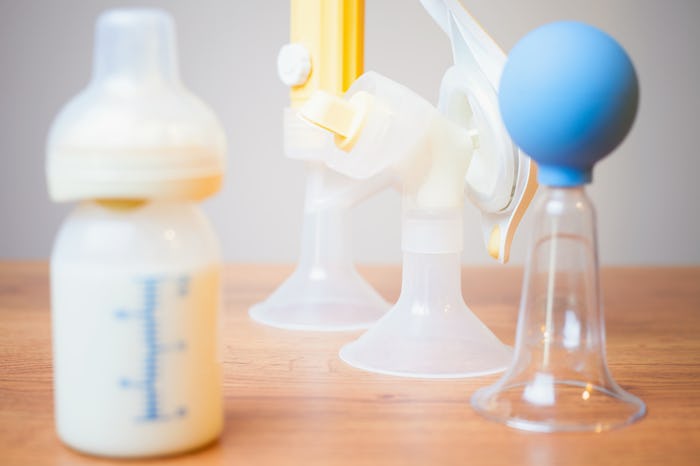Life

Pumping Can Be The Answer To Breastfeeding Engorgement & Here Are 7 Ways To Get Maximum Relief
After reading nothing but parenting books and mommy blogs for nine months, I went into labor thinking I knew everything that would come my way after my child was born. But here’s what I was absolutely not prepared for — my new milk-filled breasts expanding from a D-cup to a freaking F-cup in a matter of minutes. Yes, I experienced major breastfeeding engorgement and was looking for any way to take the pain away. I remembered reading that pumping can relieve breastfeeding engorgement, but the thought of putting an electric pump to my rock hard, throbbing chest was unimaginable. The pain rivaled that of labor and, worst of all, I had to suffer through it for a whole day.
Here’s the good news. I survived engorgement and learned a few tips along the way. It’s also worth noting that not everyone’s engorgement period will be severe as mine. That being said, you should expect some discomfort — or at least temporarily bigger, heavier breasts — two to five days after giving birth, which is when most women’s milk comes in. (Before that, your baby feeds on colostrum, a “pre-milk” specifically formulated for a newborn’s unique nutritional needs.) Also, tskin on your breasts might be tight and shiny (considering your skin could stretch at least two cup sizes instantaneously), and they might feel warm to the touch. For me, engorgement was basically like carrying around two huge boulders on the front of my body, which extended all the way into my armpits. In fact my breasts were so hard and tight that it was hard for my newborn’s tiny mouth to latch onto my sore, cracked nipples until I expressed a little milk, softening the area for him. In an effort to better prepare you for postpartum engorgement, here are a few tips to get the maximum relief.
1Nurse Frequently
I know it’s uncomfortable, but your body is trying to figure out how much milk it needs to produce for your baby. Right now it’s on overload, but it’s important to keep a consistent nursing schedule to help your milk production supply adjust. The La Leche League suggests nursing early and often, at least ten times a day (or about every two to three hours, around the clock). And make sure your baby completes eating on one side before switching to the next, and then start your next feeding on the breast you last fed — so each side is sufficiently drained.
2Hand-Express Before Feedings
If, like me, you find it hard for your baby to latch onto your rock-like breasts, take this advice from Jane Morton, a California-based pediatrician and former director of The Breastfeeding Medicine Program at Stanford University. Before each feeding session, apply warm compresses and hand-express a little milk to soften your breasts and help your baby latch on.
To get milk flowing, many moms moms suggest taking a brief hot shower, putting a rice-filled sock in the microwave for a DIY warm compress, and literally sticking your breasts in a sink filled with warm water and massaging downward until a little milk comes out.
3Gently Massage Your Aching Breasts
If you’re having trouble hand-expressing milk, try gently massaging the chest wall toward the nipple area to get your milk flowing. You can even massage your breasts while your baby noshes to help relieve some pain.
4Use A Breast Pump — But Not Too Much
Remember that your body’s milk supply is trying to stabilize, and so whatever milk your body is releasing — whether it’s through pumping or nursing — is what it’ll assume it needs to produce. Some women find that electric pumps are easier to use than manual pumping methods, but only pump until your breast is slightly softened enough for your baby to latch. In between feedings, pump just to comfort to relieve some of the pain. Too much pumping will lead to overproduction, which can extend the engorgement period even longer.
5Use Cool Compresses
Although warm compresses can help get milk flowing when you’re desperate for a little relief, Kelly Bonyata, the lactation consultant behind the popular breastfeeding resource Kellymom.com, advises women to only use warmth for a few minutes as it’ll actually increase swelling and inflammation. Instead, Bonyata suggests cool compresses for up to 20 minutes before nursing. I can say from personal experience that putting cool compresses in my nursing bra was a tiny slice of heaven in an otherwise hellish experience.
6Stock Up On Cabbage
When it comes to cool compresses, Lactation Consultant swears by using green cabbage leaves for engorgement. Weird? Maybe. But it works. Putting refrigerated or room-temperature cabbage leaves on your engorged breasts can be a mega source of pain relief, even though the science is iffy on why exactly it works. It’s thought that cabbage’s natural properties help open capillaries and get blood flowing in and out of the area, moving trapped fluid in the breasts, and relieving pressure and inflammation. And yet some experts suggest cabbage can actually decrease milk supply too much, so only leave them on for 20 minutes at a time, no more than three times per day.
7Find A Well Fitting, Supportive Nursing Bra
Trying to fit into your too-tight pre-engorgement bras could lead to plugged ducts and painful mastisis, and having a supportive sling for your boulder-like breasts can help keep a little more comfortable. And if you’re trying to dry up your milk supply, Mayo Clinic notes that a firm and supportive bra can help stop milk production.